
ATTENTION: The works hosted here are being migrated to a new repository that will consolidate resources, improve discoverability, and better show UTA's research impact on the global community. We will update authors as the migration progresses. Please see MavMatrix for more information.
Show simple item record
| dc.contributor.advisor | Zaruba, Gergely | |
| dc.contributor.advisor | Huber, Manfred | |
| dc.creator | Burns, Nicholas Brent | |
| dc.date.accessioned | 2020-09-09T20:59:39Z | |
| dc.date.available | 2020-09-09T20:59:39Z | |
| dc.date.created | 2020-08 | |
| dc.date.issued | 2020-09-02 | |
| dc.date.submitted | August 2020 | |
| dc.identifier.uri | http://hdl.handle.net/10106/29365 | |
| dc.description.abstract | Spatial and temporal gait analysis can provide useful measures for determining a person’s state of health while also identifying deviations in day-to-day activity. The SmartCare project is a multi-discipline health technologies project that aims to provide an unobtrusive and pervasive system that provides in-home health monitoring for the elderly. This research work focuses on the pressure-sensitive smart floor of the SmartCare project by using an experimental floor to develop methods for future use on a floor deployed within a home. This work presents a procedure to automatically calibrate a smart floor’s pressure sensors without specialized physical effort. The calibration algorithm automatically filters out non-human static weight and only retains weight generated by human activity. This technique is designed to correctly translate sensor values to kg weight units even when direct independent access to the pressure sensors is prohibited and when a shared tile floor sits above the sensor grid. Using the calibrated sensor values, machine learning techniques are used to extract individual contact points on a smart floor generated by a person’s walking cycle. This work presents a three-step process of building and training neural network models of different architectures (feedforward, convolutional, and autoencoder) to learn the unique non-linear relationship between weight distribution, tile coupling, and physical floor variations. Finally, this research work presents a recursive Hierarchical Clustering Analysis algorithm that uses the individual contact points generated by the floor model to extract individual footfalls of a person during a walking cycle. The footfall clusters are further grouped and segmented into walking sequences. Spatial gait analysis is performed on the resulting footfall clusters within each walking sequence to measure a variety of gait parameters. The results of the gait analysis are compared to those generated by a high-resolution mat alternative showing comparable results for most of the computed gait metrics. | |
| dc.format.mimetype | application/pdf | |
| dc.language.iso | en_US | |
| dc.subject | Machine learning | |
| dc.subject | Smart floor | |
| dc.subject | In-home healthcare | |
| dc.subject | Assistive health technologies | |
| dc.subject | Neural networks | |
| dc.subject | Clustering | |
| dc.subject | Gait analysis | |
| dc.subject | Sensor calibration | |
| dc.subject | SmartCare | |
| dc.title | Learning Health Information From Floor Sensor Data Within A Pervasive Smart Home Environment | |
| dc.type | Thesis | |
| dc.degree.department | Computer Science and Engineering | |
| dc.degree.name | Doctor of Philosophy in Computer Engineering | |
| dc.date.updated | 2020-09-09T20:59:39Z | |
| thesis.degree.department | Computer Science and Engineering | |
| thesis.degree.grantor | The University of Texas at Arlington | |
| thesis.degree.level | Doctoral | |
| thesis.degree.name | Doctor of Philosophy in Computer Engineering | |
| dc.type.material | text | |
Files in this item
- Name:
- BURNS-DISSERTATION-2020.pdf
- Size:
- 4.182Mb
- Format:
- PDF
This item appears in the following Collection(s)
Show simple item record


